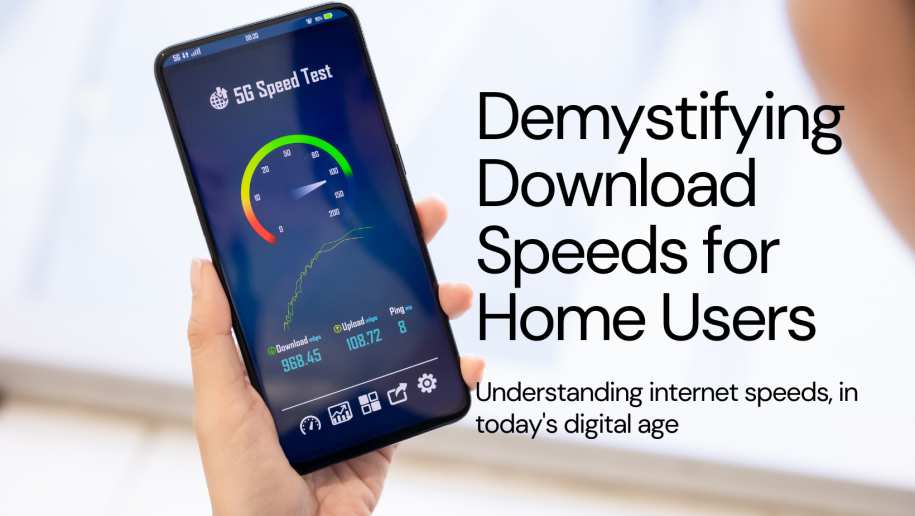In today’s digital age, understanding internet speeds can feel like navigating a maze of technical jargon. Whether you’re streaming movies, video calling friends and family, or simply browsing the web, the speed of your internet connection plays a crucial role in your online experience. In this guide, we’ll demystify download speeds, uploads, and latency (ping), and explore what speeds are needed for common online activities.
What is Download Speed?
Download speed refers to how quickly data can be transferred from the internet to your device. When you’re streaming a movie, downloading a game, or opening a web page, you’re utilizing your download speed. This is typically measured in megabits per second (Mbps) or gigabits per second (Gbps).
What is Upload Speed?
Upload speed is the opposite of download speed. It’s the rate at which data is transferred from your device to the internet. When you’re sending emails, uploading photos to social media, or video conferencing, you’re using your upload speed. Like download speed, this is also measured in Mbps or Gbps.
The Importance of Upload Speeds
While download speed often takes the spotlight when discussing internet performance, upload speed is equally important, especially in today’s connected world. Here are a few reasons why upload speed matters:
1. Sending Files and Emails
- Efficiency: A higher upload speed allows you to send files, photos, and emails faster. Whether you’re attaching documents to an email or uploading images to the cloud, a quicker upload speed means less time waiting for the transfer to complete.
2. Video Conferencing and Online Meetings
- Quality: Video conferencing platforms like Zoom, Microsoft Teams, and Skype rely on upload speed for transmitting your video feed to other participants. A higher upload speed ensures smoother video calls with better clarity and fewer interruptions.
3. Uploading Content to Social Media
- Timeliness: If you’re sharing videos or images on social media platforms like Facebook, Instagram, or YouTube, a faster upload speed means your content goes live quicker. This is particularly important for content creators and businesses looking to engage their audience promptly.
4. Cloud Backup and Storage
- Reliability: Many users rely on cloud services for backing up important files and documents. With a higher upload speed, you can seamlessly back up your data to the cloud without long wait times, ensuring your files are safe and accessible.
5. Online Gaming and Streaming
- Smooth Gameplay: While download speed is crucial for online gaming, upload speed is equally vital for multiplayer games. Uploading your actions in real-time to the game server requires a good upload speed to ensure others see your moves without delay.
6. Remote Work and Virtual Collaboration
- Productivity: As remote work becomes more common, a faster upload speed enhances productivity. Uploading large files to share with colleagues, participating in virtual meetings, and collaborating on documents in real-time all benefit from a higher upload speed.
Speeds for Common Online Activities
Now let’s break down the speeds you’ll need for various online activities:
1. Email and Web Browsing
- Speed Needed: 1-5 Mbps
- Sending and receiving emails, browsing websites, and reading articles require minimal bandwidth. Even the most basic internet plans can handle these tasks comfortably.
2. Video Streaming (Standard Definition)
- Speed Needed: 3-4 Mbps
- Watching videos in standard definition (SD) quality on platforms like Netflix, YouTube, or Hulu will require speeds of around 3-4 Mbps to avoid buffering.
3. Video Streaming (High Definition)
- Speed Needed: 5-8 Mbps
- Enjoying movies and TV shows in high definition (HD) quality requires faster speeds. Streaming platforms recommend speeds of 5-8 Mbps for HD streaming.
4. Online Gaming
- Speed Needed: 10-20 Mbps
- Online gaming demands a stable connection with low latency. Speeds of 10-20 Mbps are generally sufficient for smooth gameplay, but faster speeds can reduce lag.
5. Social Media and Browsing with Multiple Devices
- Speed Needed: 10-25 Mbps
- If you have multiple devices connected to the internet simultaneously for social media, web browsing, or light streaming, speeds of 10-25 Mbps should suffice.
6. Video Conferencing (FaceTime, Zoom, Skype)
- Speed Needed: 1-8 Mbps
- Video conferencing platforms like FaceTime, Zoom, or Skype require varying speeds depending on the video quality. For standard video calls, 1-2 Mbps is adequate, while HD video calls may need 4-8 Mbps.
7. Downloading Large Files
- Speed Needed: 50+ Mbps
- When downloading large files, such as software updates, movies, or games, faster speeds are beneficial. Speeds of 50 Mbps or higher can significantly reduce download times.
Conclusion
Understanding download speeds, upload speeds, and latency can empower you to choose an internet plan that meets your needs. Whether you’re a casual web surfer, a binge-watcher, a gamer, or a remote worker, having the right internet speed ensures a seamless online experience. Take these guidelines into account when selecting an internet plan, and enjoy a fast and reliable connection for all your online activities, both downstream and upstream.

